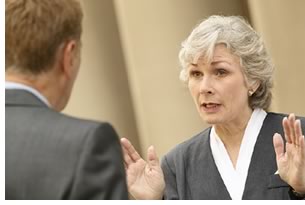

01/2005
 Marketing
master Joan Capelin, Hon. AIA, offers 29 principles for communicating
architectural achievement to clients in her latest book, Communication
by Design: Marketing Professional Services. Here are synopses
of 10 to get started: just do it, think as your client, follow the Golden
Rule, watch your Netiquette, lose well, tell them who you are, nothing
of value is free, think before you write, get connected, follow up beyond
belief.
Marketing
master Joan Capelin, Hon. AIA, offers 29 principles for communicating
architectural achievement to clients in her latest book, Communication
by Design: Marketing Professional Services. Here are synopses
of 10 to get started: just do it, think as your client, follow the Golden
Rule, watch your Netiquette, lose well, tell them who you are, nothing
of value is free, think before you write, get connected, follow up beyond
belief.
People often get tied up in definitions when trying to differentiate the elements of marketing professional services, Capelin says in her chapter “Just Do It.” So she offers definitions and examples in a way that encourages the reader beyond contemplation to action. For example:
Marketing. Research the world around you constantly to keep up with changing opportunities for which you can show unquestionably that you are the superior service provider.
Selling. Pursue your commissions and close the deal based on marketing. And remember, the most successful selling is based on what the client wants, not necessarily on what you have done in the past and are trying to sell again.
Public relations. Do good work, continually position yourself based on marketing research, and let the world know about it (be sure your people know these things, too) through a wide range of media.
Advertising. You are buying the attention of readers, listeners, or viewers of targeted media—hopefully. The most effective advertisements are typically those repeated the most often, so this can be a prohibitively expensive tactic.
Branding. A fixed point in a moving world, this concept strives to tie a word, phrase, concept, or even color (think White=Meier) to a strong, positive connection to you. For most design firms, though, it is much easier to explain this to your colleagues as “establishing our reputation.”
Integrated marketing communication
Product (that should actually be “service,” but Capelin was
going for four Ps) price, place, and promotion need to be in sync and
in sequence. And a central authority within the firm has to stick to
the hard work to accomplish that. For example, as graphic designer Doug
Akagi says, “Come to me with a problem, and I’ll give you
a solution. Come to me with a solution, and I’ve got a problem.”
 Think as your client
Think as your client
What might seem like an excellent public-relations coup to you could
also be a marketing secret to your client. Be sensitive to your client’s
roll-out plan. Get the ground rules clarified at the outset; preferably
in writing. And make it clear whether you get prominent design credit
for the project.
Follow the Golden Rule
Sometimes, you have to deliver bad news. And how you handle that is remembered.
Nobody likes bad surprises: not you; not your client. And, yet, there
is a positive side to almost every negative circumstance. The fact
is, people like to buy from people who like to sell. Treat your clients
as you would have them treat you, and you will build trust, which,
in turn, builds business.
Mind your Netiquette
One thing worse than sending a “business-ending” e-mail to
a client is also hitting the “Send-to-All” key. When it’s
easy and instant, it is also very risky. Think, get review, and think
again before you send an e-mail—especially if it’s a mass
e-mail in a stressful situation. Also, put yourself in your receivers’ shoes.
Are there large attachments? Is it what everybody on your list wants
or could use? The precision that is possible with e-mail delivery has
likewise upped all of our expectations.
Lose well
When you don’t win a commission, what may be remembered more than
anything else is how you conducted yourself accordingly. There is nothing
wrong—and probably everything right—about congratulating
a competitor on winning a commission.
 Tell ’em who you are
Tell ’em who you are
“Two inches outside the design professions, no one understands what
you do on a daily basis, nor appreciates your impact,” Capelin writes.
Her advice to overcome that is to be prepared to offer an interesting anecdote
or explanation to which people can connect who are more than those two
inches away. At your next staff meeting, have everyone describe briefly
what they do. See if they talk in terms of the effect of what they do and
that their message is in line with your firm’s desired reputation.
Try your hardest to avoid being like the people described by Garrison Keillor, “having
a conversation with [some] people is like dragging an unconscious person
up a cliff.”
Nothing of value is free
The longer you go without being paid outstanding billings, the less you
will be paid, if at all. Too few clients truly understand that your
negative cash positions are, in reality, a detriment to themselves
when that position renders you unable to deliver your full scope of
highest-quality services. (And, incidentally, this is true of your
payments to your consultants as well.) “Always do right,” advised
Samuel Clemens. “This will gratify some people and astonish the
rest.” Likewise, it’s usually best to assume that your
clients with outstanding billings also intend to do right. The trick
is applying gentle but persistent reminders on the people actually
in charge of paying your client’s bills. And finding out who those persons
are and how their payment system works should be one of the first things
you establish when you begin working with a new client.
The other issue here is getting paid for additional services. Beware the client who insists on selecting by bid alone. And whenever a client asks for services beyond the contract, offer back your standard contract-extension form. Furthermore, have you reviewed your increased ability to deliver services lately and equated them to the potential for increasing your fees?
 Think before you write
Think before you write
Capelin quotes Friedrich Bohm, FAIA, of NBBJ, who says that if you can’t
talk about a project coherently, you aren’t yet in a position to
design it. “The same coherence pertains to a firm’s marketing
materials,” she writes. Capelin then offers an exercise of 20 questions
to answer to focus and schedule a basic press release and spin-off communications
(including, again, “Do we have the client’s permission to
tell this story?”).
Get connected
“In addition to being personally and professionally responsible,
you must also be actively engaged,” Capelin advises. Being involved
in nonprofit organizations is part of an obligation that brings with it
opportunity. It is a demanding second job to take on a leadership role
in community and professional organizations, but there are returns, such
as sharper skills in presentation, event planning, and organizational management.
As in every other investment of your time—and the time of those around
you—there is an expectation of some sort of return (usually intangible,
in this case). Be sensitive to that. Make assignments clear and recognize
efforts generously. Document assignments, accomplishments, and communications.
Get people in your firm involved and have them share their lessons learned
through your company newsletter or intranet. You might even provide meeting
space at your firm at no charge to the organization.
FUBB
This chapter is actually found toward the beginning of Communication
by Design, but is a good conclusion for this review. FUBB, a term Capelin
says she uses daily, means “follow up beyond belief.” Capelin
notes: “Even in an industry where ‘God is in the details’ and
where an omission from a working drawing affects life and safety, FUBBing
does not come naturally.”
Are your people—from marketing to accounting—assiduous about following up to see if the right communication showed up on the right desk, on time, every time? Everybody should be remembering to pass any new leads on to the appropriate people; meeting proceedings need to be recorded, shared, and filed; when reporters interview you, supply them with graphics when you can; record clippings; and thank editors and writers for their work. People who refer work to you are golden—thank them, too. And, with follow-up communication, think “interactive.” Consider a client exit interview to see what went particularly well and what did not. One firm Capelin works with goes a step further, she says, with a post-occupancy survey. After project completion, but before guarantees expire, this interior-design firm thoroughly examines the materials and functional performance of their work. They learn about satisfaction, reconnect their relationship after contract completion, and learn about new developments in the client’s own world. In short, with one well-executed effort, they are doing everything from marketing to FUBBing.
Copyright 2005 The American Institute of Architects.
All rights reserved. Home Page ![]()
![]()

 includes significant portions
of Joan Capelin’s earlier
includes significant portions
of Joan Capelin’s earlier